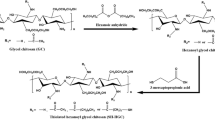Abstract
Purpose. To improve the mucoadhesive properties of polycarbophil by the introduction of sulfhydryl groups.
Methods. Mediated by a carbodiimide, cysteine was covalently bound to polycarbophil (PCP) forming amide bonds between the primary amino group of the amino acid and the carboxylic acid moieties of the polymer. The amount of covalently attached cysteine and the formation of disulfide bonds within the modified polymer were determined by quantifying the share of thiol groups on the polymer conjugates with Ellman's reagent. The adhesive properties of polycarbophil-cysteine conjugates were evaluated in vitro on excised porcine intestinal mucosa by determining the total work of adhesion (TWA).
Results. Depending on the weight-ratio of polycarbophil to cysteine at the coupling reaction, e.g., 16:1 and 2:1, 0.6 ± 0.7 μmole and 5.3 ± 2.4 μmole cysteine, respectively, were covalently bound per g polymer. The modified polymer displayed improved internal cohesive properties due to the formation of interchain disulfide bonds within the polymer in aqueous solutions at pH-values above 5. Adhesion studies revealed strongly improved adhesive properties. Whereas the TWA was determined to be 104 ± 21 μJ for the unmodified polymer, it was 191 ± 47 μJ for the polymer-cysteine conjugate 16:1 and 280 ± 67 μJ for the polymer-cysteine conjugate 2:1.
Conclusions. Polymers with thiol groups might represent a new generation of mucoadhesive polymers displaying comparatively stronger adhesive properties.
Similar content being viewed by others
REFERENCES
M. J. Tobyn, J. R. Johnson, and P. W. Dettmar. Factors affecting in vitro gastric mucoadhesion II. Physical properties of polymers. Eur. J. Pharm. Biopharm. 42:56–61 (1996).
A. Bernkop-Schnürch, C. Humenberger, and C. Valenta. Basic studies on bioadhesive delivery systems for peptide and protein drugs. Int. J. Pharm. 165:217–225 (1998).
B. Naisbett and J. Woodley. The potential use of tomato lectin for oral drug delivery. Lectin binding to rat small intestine in vitro. Int. J. Pharm. 107:223–230 (1994).
J. M. Irache, C. Durrer, D. Duchêne, and G. Ponchel. Bioadhesion of lectin-latex conjugates to rat intestinal mucosa. Pharm. Res. 13:1716–1719 (1996).
A. Bernkop-Schnürch, F. Gabor, M. P. Szostak, and W. Lubitz. An adhesive drug delivery system based on K99-fimbriae. Eur. J. Pharm. Sci. 3:293–299 (1995).
J. R. Gum, Jr., J. W. Hicks, N. W. Toribara, E.-M. Rothe, R. E. Lagace, and Y. S. Kim. The human MUC2 intestinal mucin has cysteine-rich subdomains located both upstream and downstream of its central repetitive region. J. Biol. Chem. 267:21375–21383 (1992).
G. H. Snyder, M. K. Reddy, M. J. Cennerazzo, and D. Field. Use of local electrostatic environments of cysteines to enhance formation of a desired species in a reversible disulfide exchange reaction. Biochim. Biophys. Acta 749:219–226 (1983).
G. H. Snyder. Intramolecular disulfide loop formation in a peptide containing two cysteines. Biochemistry 26:688–694 (1987).
Methods for covalent chromatography using Activated Thiol Sepharose 4B or Thiopropyl Sepharose 6B. In, Affinity Chromatography: Principles and Methods, Pharmacia, Uppsala, 1996, pp. 106–111.
C.-M. Lehr, J. A. Bouwstra, E. H. Schacht, and H. E. Junginger. In vitro evaluation of mucoadhesive properties of chitosan and some other natural polymers. Int. J. Pharm. 78:43–48 (1992).
A. Bernkop-Schnürch and M. Kraijcek. Mucoadhesive polymers for peroral peptide delivery: synthesis and evaluation of chitosan-EDTA conjugates. J. Contr. Rel. 52:1–16 (1998).
H. S. Ch'ng, H. Park, P. Kelly, and J. R. Robinson. Bioadhesive polymers as platforms for oral controlled drug delivery II: Synthesis and evaluation of some swelling, water-insoluble bioadhesive polymers. J. Pharm. Sci. 74:399–405 (1985).
S. A. Mortazavi and J. D. Smart. An investigation into the role of water movement and mucus gel dehydratation in mucoadhesion. J. Contr. Rel. 25:197–203 (1993).
G. Ponchel, F. Lejoyeux, and D. Duchêne. Bioadhesion of poly(acrylic acid) containing-systems. Thermodynamical and rheological aspects. Proceed. Intern. Symp. Control. Rel. Bioact. Mater. 18:111–112 (1991).
Author information
Authors and Affiliations
Rights and permissions
About this article
Cite this article
Bernkop-Schnürch, A., Schwarz, V. & Steininger, S. Polymers with Thiol Groups: A New Generation of Mucoadhesive Polymers?. Pharm Res 16, 876–881 (1999). https://doi.org/10.1023/A:1018830204170
Issue Date:
DOI: https://doi.org/10.1023/A:1018830204170




